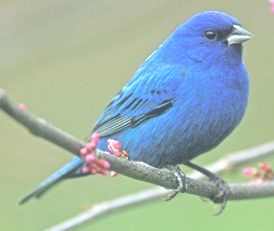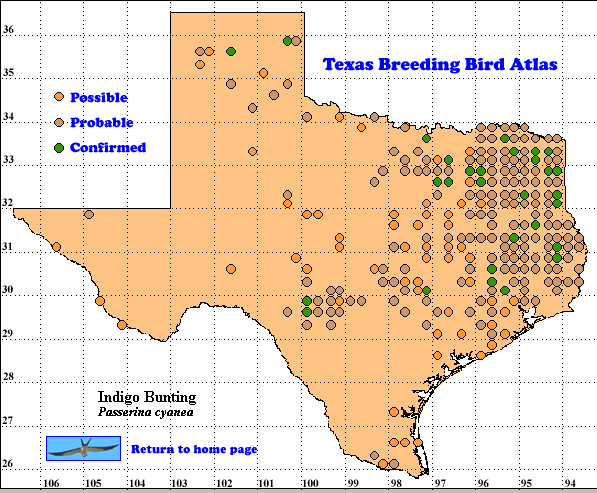The male Indigo Bunting usually does not acquire its full blue plumage until the second breeding season, a sequence know as “delayed maturation,” found in some grosbeaks, buntings and finches. Therefore only about half of first-year males are able to breed successfully, a proportion well below older males (Payne 1992, Pyle 1997).
While breeding habitats used by Indigo Buntings in east Texas are typical of the deciduous forests of the eastern United States, in the Trans-Pecos breeding is apparently mostly confined to riparian areas (Lockwood and Freeman 2004). This is also the case in Arizona (Corman 2005), Colorado (Righter 1998) and southwest Utah (RCT) and possibly the other western states where Indigo Buntings breed in widely scattered locations.
DISTRIBUTION. During the 1987-1992 field work of the TBBA project, atlasers found Indigo Buntings breeding most abundantly in the Pineywoods and adjacent portions of other regions. Most additional confirmed records were found in the Rolling Plains and Edwards Plateau regions (see region map in Lockwood and Freeman [2004]).
East Texas forms the southwest corner of the area of highest breeding abundance of this species. The area extends east to southern Georgia, north along the Atlantic Coast to Delaware, west including Pennsylvania, Ohio, southern Michigan, Wisconsin, Illinois , Missouri, eastern Kansas and eastern Oklahoma. Outside this area relative abundances drop rapidly. Breeding also occurs in scattered areas on the Great Plains and through the southwest to California (Sauer et al. 2005). Indigo Buntings winter primarily in south Florida, from central Mexico south to Colombia and Venezuela and in the Greater Antilles (Payne 1992, Howell and Webb 1995).
SEASONAL OCCURRENCE. In spring migrating Indigo Buntings arrive in Texas from February 25 to June 18 with most coming between late March and late May. Breeding occurs from April to late July based on egg dates from May 15 to July 7 and TBBA confirmed breeding records from March 29 to July 26. In Oklahoma Sutton (1967) found a large fledgling being fed by a female on September 14. Southbound migrants are present from July 14 to December 4 with peak movement between mid-August and early November. In winter this bunting is rare to locally uncommon in the lower Rio Grande valley (Oberholser 1974, Lockwood and Freeman 2004)
BREEDING HABITAT. In Texas Indigo Buntings breed from near sea level to 600 m (2000 ft) in deciduous woodlands, especially near water. Some pine trees within deciduous woods are tolerated and woodland edges are also used. The female builds the nest in low branching vegetation within 1 m (3 ft) of the ground. The open cup is constructed of soft leaves, coarse grasses and bark strips which are woven around 2 or 3 supporting stems. The nest frequently hangs below its supports and is often wrapped with spider silk. The lining is mostly fine grasses. The outside diameter is 7.4-9.4 cm (3-3.8 in), inside diameter is 4.3-6.3 cm (1.7-2.5 in), height is 5.8-10 cm (2.3-4 in) and cup depth is 3.3-4.7 cm (1.3-1.9 in; Oberholser 1974, Payne 1992).
The females usually lay 3-4 white, unmarked eggs, indistinguishable from those of Lazuli Bunting (P. amoena) and similar to, but smaller than, the eggs of Blue Grosbeak (P. caerulea). On average incubation by the female lasts 12-13 days. Nestlings normally leave the nest 9-12 days after hatching. In Texas many females attempt at least 2 broods per year. Parasitism by Brown-headed Cowbirds (Molothrus ater) is a problem for Indigo Buntings (Harrison 1979, Payne 1992).
STATUS. Indigo Buntings are common to locally abundant summer residents and abundant migrants in the eastern half of Texas (Lockwood and Freeman 2004). Breeding Bird Survey (BBS) observers detected this species on 63 routes in Texas and data from these routes produced a 95% confidence interval (There is a 95% chance that the actual population trend will be between these two numbers.) of -1.8 to +0.4% population change per year for the period 1966-2005. This interval suggests the Texas trend is probably similar to the statistically significant trend of -0.6% for the periods 1966-2005 and 1980-2005 for the Indigo Bunting’s range in the United States and Canada (Sauer et al. 2005). This relatively small change is a very hopeful sign for the future of this bunting in Texas. Text by Robert C. Tweit (2006)

